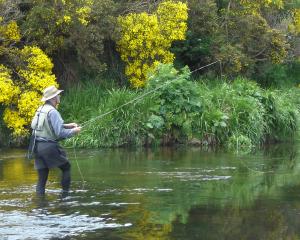
All rivers are cool for this time of year, the Taieri being below 15°C in the upper and middle reaches and only a degree warmer on the Taieri Plain.
Interspersed with cool nights we have had a couple of hot days, which will have boosted the hopes of the cicada hunters.
The Pomahaka rose to 50cumecs this week when it was only 3cumecs last week. Luckily, it is dropping quickly and provided there is no more rain should be in good order this weekend and the extra water could bring in a run of sea trout.
On the warm calm days that I have been out on various rivers I have seen falls of mayfly spinners.
Spinners are poor flyers so hide out in the bankside vegetation until it is warm enough and calm enough to make it safely back to the river to lay their eggs.
The rises to spinners can be similar to rises to duns when the spinners are alive but as soon as their eggs are deposited the spinners die and fall to the water with their wings out flat.
The rise to spent spinners, as they are called, is a gentle sip with very little disturbance to the water and little indication of the size of the sipper.
Trout can be very choosy when feeding on spinners but can provide great fishing as well as a challenge.
There are lots of fly patterns tied to imitate spinners and it is just a matter of trying various patterns to find one that works for you.
My go-to pattern is an upside-down spinner, usually a size 14 which is a good representation of the most common mayfly spinners.
I fished the middle reaches of the Taieri this week on what turned out to be the hottest day I have fished so far this season. It was barely even warm when I started and the water was 18°C. I fished a favourite ripple to start and did not see or touch a fish, although I did see a rise just above it.
When I eventually got to this rising fish, it took my nymph but I did not hook it.
By this time there were a couple more rising under the bushes on the far side and because of the low water I was able to get within casting range.
After a few goes I got the fly in the right place as the fish cruised up and down. It weighed just over 2kg.
The second fish was a bit smaller. This is where the story really begins. The next ripple up looked promising, although I could not spot any fish in it.
Fishing it blind with a weighted nymph, after a few casts I struck into a fish which leapt high out of the water before tearing off down the river. It was 1.5kg.


